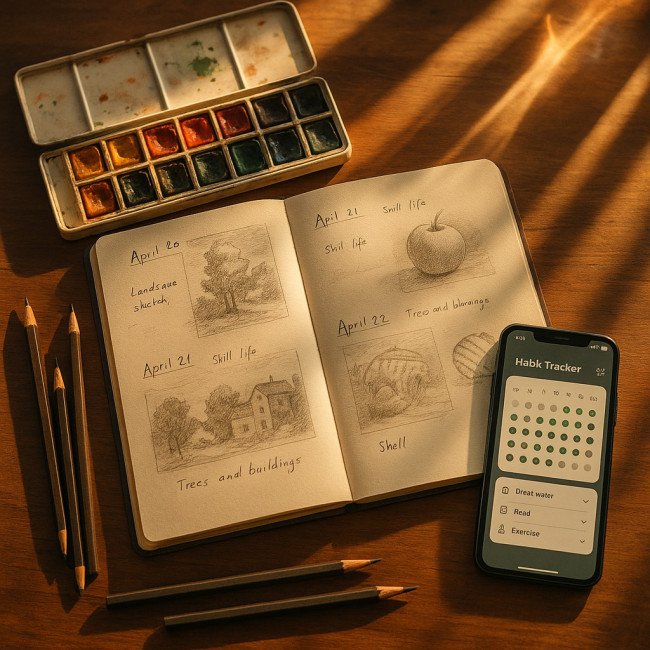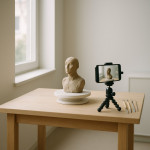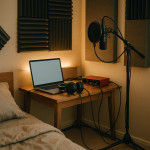How daily sketching logs accelerate style discovery and keep you accountable
A daily sketching log turns scattered practice into a structured journey. By documenting each drawing session, you reveal patterns, measure growth and—most importantly—hold yourself accountable. Follow this guide to launch a log that uncovers your unique style faster while fitting neatly into a busy creative life.
Why a daily sketching log changes everything
Many artists swear by sketchbooks, yet few track what they learn from every page. A daily sketching log closes that feedback loop. Recording date, duration, tools and reflections transforms practice from vague repetition into targeted experimentation.
1. Accelerated style discovery
Style rarely appears overnight. When you archive each doodle with quick notes—“loved the chunky marker lines” or “watercolour wash too muddy”—you identify recurring aesthetics and problem-solve faster. After 30 days, themes emerge: preferred colour palettes, line weights or composition rhythms. The log turns gut feeling into visible evidence, shortening the trial-and-error cycle.
2. Built-in accountability
Consistency beats intensity for artistic growth. A simple checkbox or habit tracker beside every log entry nudges you to show up daily. Publicly sharing snapshots on social platforms—or in specialised communities aligned with daily skill-sprint challenges—adds social pressure that keeps motivation high even when energy dips.
3. Objective progress metrics
Hours clocked, subjects explored and techniques tested become quantifiable. Over weeks, you can correlate milestones—first clean inked page, breakthrough in shading—with the number of sketches completed. Those numbers fuel confidence and inform the next learning blocks, echoing strategies in structured daily shooting routines.
Setting up your daily sketching log in three steps
Step 1 – Choose the right medium
Whether you love paper or pixels, pick a format you'll actually use. Below is a quick comparison to help decide:
| Criteria | Analog notebook | Digital app |
|---|---|---|
| Portability | Requires carrying sketchbook & tools | Works on phone or tablet already in your bag |
| Revision | Pages are permanent; mistakes stay visible | Layers & undo for fearless experimentation |
| Data capture | Manual page numbers | Auto time-stamps, tag search, cloud backup |
| Distraction risk | Zero notifications | High if not using focus mode |
Step 2 – Define log fields
- Date & time of session
- Duration (e.g., 25-minute Pomodoro)
- Subject & prompt (gesture, portrait, environment)
- Tools (HB pencil, Procreate brush set)
- Reflection (one win, one tweak for next time)
Keep fields short; spending more time logging than drawing defeats the purpose.
Step 3 – Schedule the habit
Attach your daily sketching log to an existing routine—morning coffee or post-lunch break. A fixed slot removes decision fatigue. If travel interrupts, use a pocket notebook or a notes app to jot insights and photograph sketches for later upload.
From logging to learning: turning entries into insights
Weekly reviews
Every Sunday, skim your last seven entries. Highlight moments where you felt “flow” or produced unexpected marks. Circle recurring weaknesses—maybe proportions wobble when you rush. Set one micro-goal for the next week, mirroring the reflective loops advocated in self-directed learning frameworks.
Monthly mash-ups
Print thumbnails or create a digital grid of the month's standout sketches. Arrange them chronologically to visualise evolution, or group by technique to compare quality. Patterns will leap out: improved hatching, bolder silhouettes, cohesive colour schemes. Use these clues to refine your style statement.
Quarterly deep dives
Every three months, grade your work against personal benchmarks—line confidence, anatomy accuracy, storytelling. Track average scores in a spreadsheet. Seeing numbers climb, even slowly, crushes imposter syndrome.
Staying accountable beyond willpower
Peer circles
Share weekly highlights in a small group chat. Constructive eyes spot growth you overlook and challenge you to push further. If peers come from diverse disciplines—illustrators, sculptors, photographers—the cross-pollination spurs fresh ideas.
Public micro-blogs
Posting time-lapse reels or annotated slides on platforms like Artfolio training boards invites wider feedback and potential recruiter visibility. Be transparent: include the date and one lesson per post. Consistency signals reliability to future clients.
Gamified trackers
Apps that visualise streaks or award badges turn the humble daily sketching log into a mini-game. Loss aversion—the urge to avoid breaking a streak—boosts persistence, just as in habit-tracking techniques used by performing artists.
Common roadblocks and how to bypass them
“I don't have time”
Set a five-minute floor. Even a thumbnail counts if you fill the log. Over time, small wins snowball into momentum.
“I never know what to draw”
Maintain a prompt list: random objects, one-word emotions, or gesture poses. Roll a die or use an online randomiser to decide.
“My sketches all look the same”
Introduce constraints—non-dominant hand, 2-minute timer, single-stroke drawings. Constraints jolt you out of autopilot.
Quick self-assessment quiz
FAQ
- Do I need advanced drawing skills before starting a daily sketching log?
- No. The log helps beginners and pros alike. Beginners gain structure; professionals pinpoint subtle refinements.
- What if I miss a day?
- Resume the next day without guilt. Gaps happen; the trend matters more than a perfect streak.
- Should I keep my log private or public?
- Both have merits. Private logs encourage honesty, while public posts build network visibility. Hybrid approaches work too.
- How long before I notice a distinct personal style?
- Most artists report clear shifts after 60–90 consecutive entries, though results vary.
- Can digital logs replace a physical sketchbook?
- Yes, if the interface feels natural and distraction-free. Choose the medium that minimizes friction.
Take the first step today

Allocate ten minutes, grab your favourite tool and create the very first entry in your daily sketching log. One small page today can reveal a signature style in months—not years. If you crave deeper practice structures, explore our guide on daily practice frameworks for creatives. Ready to commit? Start logging now and watch your artistic identity crystallise.
Need accountability buddies? Join the comment section below and post your Day 1 sketch summary. Let's grow together!











